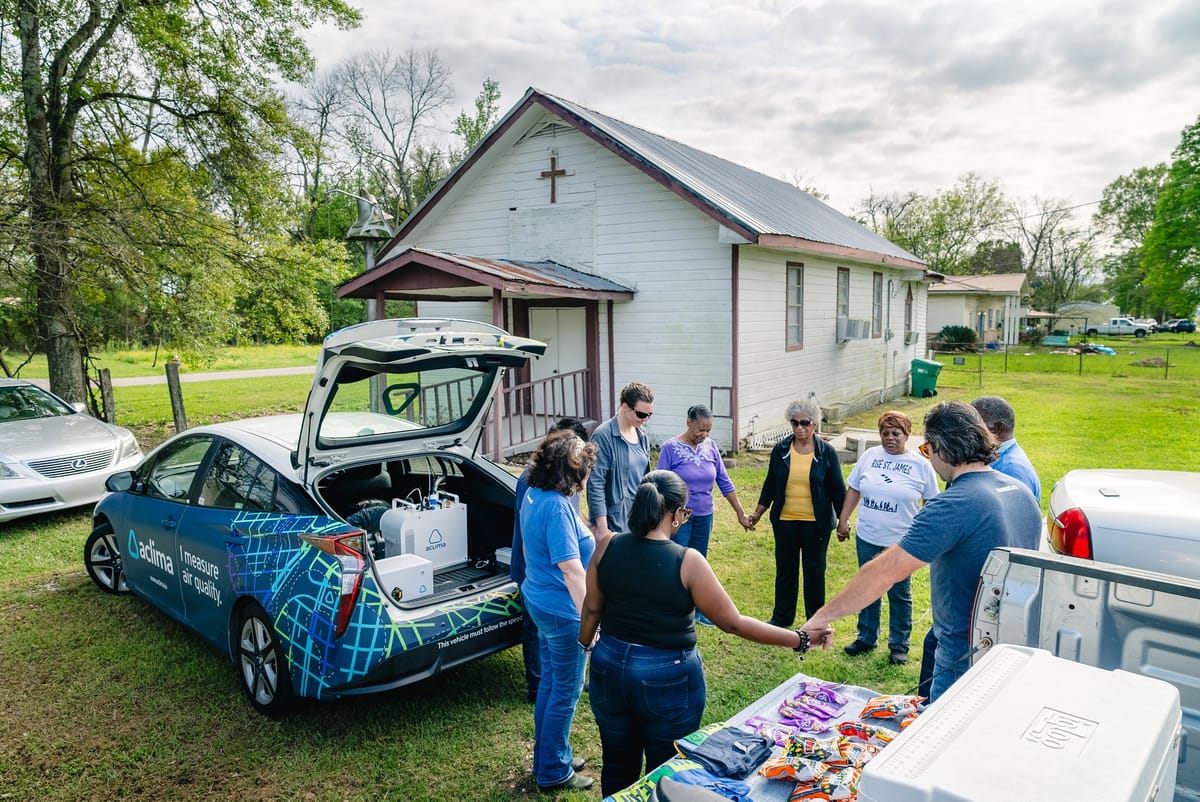Lawmakers take aim at community air monitoring in Louisiana
Republican legislators have blunted the impact of citizen-led air monitoring, which is set to receive millions from the feds.

Published in the Capital B, Public Health Watch, Energy News Network, the Louisiana Illuminator, Verite
In 2022, decades of advocacy by the Louisiana Environmental Action Network to address poor air quality near industrial facilities took a significant leap forward.
That’s when the Biden Administration awarded more than $50 million through the Inflation Reduction Act to increase air quality monitoring in some U.S. communities historically overburdened by pollution.
A year later, LEAN, a nonprofit environmental advocacy group, got $500,000, which it used to deploy a fleet of mobile air monitoring vehicles. For three months earlier this year, the cars cruised up and down the Mississippi River, collecting continuous air quality data along a 300-mile route in southwest Louisiana known as “Cancer Alley.”

Marylee Orr, LEAN’s executive director, has called the project a “dream” come true for her and the organization she founded in 1986.
“I get teary-eyed because for me, it’s been a lifetime of trying to find this kind of technology that communities could have,” Orr said during a virtual community meeting in January to roll out the project.
Now Louisiana will likely become one of the first states to push back on such community-led efforts. A Republican-backed bill headed to the governor's desk will implement standards prohibiting data collected through some community air monitoring programs like LEAN’s from being used in enforcement or regulatory actions tied to the federal Clean Air Act.
“(Lawmakers) are making one hurdle after another to stop communities and discourage them from collecting any data by saying even if you collected it, we’re not going to count it; it’s not going to be important,” Orr said.
The industry-backed bill passed the House Wednesday on a 75-16 vote. The amended version returns to the Senate Monday, where an earlier version passed by an overwhelming majority.
What’s happening in Louisiana could be an indication of what’s to come elsewhere. A similar measure is up for consideration in the West Virginia Legislature.
Meanwhile, millions more in IRA grants are up for grabs for community-based groups, state, local and tribal agencies to do their own air monitoring in low-income and disadvantaged areas.
Localized air monitoring efforts allow marginalized communities overburdened by polluting industries to force transparency about the air they breathe and push state leaders to hold industry more accountable for harmful emissions.
Proponents of the new standards in Louisiana frame it as an attempt to bring more uniformity and standards to community air monitoring. But in a letter to one lawmaker, Region 6 Environmental Protection Agency Administrator Earthea Nance said the law would conflict with federal law, which states that "various kinds of information other than reference test data ... may be used to demonstrate compliance or noncompliance with emission standards.”
Environmental advocates view the bill as a way to protect industry’s bad actors.
“The petrochemical industry is working with Louisiana legislators to inhibit community air monitoring because they know full well that they are polluting the air,” said Anne Rolfes, director of the Louisiana Bucket Brigade.
Since it was established in 2000, the Louisiana Bucket Brigade has offered residents living near industrial facilities a low-cost, air monitoring tool approved by the U.S. EPA. The group’s name comes from the industrial-size buckets that contain monitoring equipment that members use to collect their own air samples around industrial facilities in their neighborhoods.
“It shows that they are scared of science and scared of the facts,” Rolfes said. “The power is on our side."
Sponsor mum on bill
Sen. Eddie Lambert, R-Gonzalez, whose legislative district includes three of the most heavily industrialized parishes in southeast Louisiana, sponsored the bill. It mandates that any air monitoring data used for enforcement and regulation must come from the most up-to-date EPA-approved equipment.
Analysis of that data can now only be conducted by labs approved by the state, which currently lists 175 accredited labs.
According to Stacey Holley, chief of staff for the Louisiana Department of Environmental Quality, the accreditation process can take between nine months and a year. The time is shorter for labs and research facilities wanting to amend their existing accreditation, she said.
Lambert did not return multiple emails or calls seeking comment on his bill. During a previous committee hearing, Lambert said the measure would ensure the public had accurate air quality information in this “age of the internet and disinformation.”
The Louisiana Chemical Association said the new standards don’t stop anyone from doing community air monitoring.
“Senator Lambert’s bill encourages that any air monitoring being conducted by individuals or organizations adhere to basic standards that EPA and LDEQ follow when testing air quality in the community,” Greg Bowser, president and chief executive officer of the statewide lobbying group, said in a statement. “These are the same standards a facility must meet when it complies with air monitoring requirements under their approved permits.”
Opponents say they need to do their own monitoring because the LDEQ is apathetic to concerns around air quality and the agency is slow to respond to spikes in pollutants detected by community air sensors.

“Essentially, every time a community member reports an air quality problem, whether it's a dust cloud or toxic odors, DEQ doesn't respond immediately,” said Kim Terrell, a research scientist and director of community engagement at the Tulane Environmental Law Clinic in New Orleans. “Part of that is that the agency is underfunded and understaffed. And part of that is that responding to residents' complaints aren't as big of a priority as they should be.”
Holley did not respond to inquiries related to those allegations.
In earlier committee testimony, Terrell said community-based air monitoring provides the best indication of air quality within certain geographical areas. She told lawmakers that reliable data can come from sources besides what the bill deems as the “gold standard” of air quality monitoring.
“There are other types of monitoring technologies that can provide useful data beyond the very limited techniques that are required in that bill,” she said.
Rolfes views the new standards and the most recent actions of Republican Gov. Jeff Landry, who took office in January, as troubling signs that Louisiana leaders want to dial back accountability and enact a pro-oil and gas industry stance.
“The legislators involved in this are showing us that … the petrochemical industry is worth more than the health of people in this state,” she said.
Mobile monitoring fills gaps
LDEQ’s air monitoring system consists of 40 stationary air quality sensors across a sprawling state that has among the highest emissions of toxic and greenhouse gasses in the country.

Terrell said LDEQ’s monitors are often insufficient to capture “real time” air quality data because many are too far away from “fence line” communities, don’t measure certain harmful pollutants or are unable to detect spikes depending on their position and wind flow.
She added that the kind of 24-hour, seven days a week air monitoring LEAN’s program did is a way to bridge those gaps.
LEAN was among four entities awarded a total of $2.4 million for community air monitoring in Louisiana. The other recipients were LDEQ, the Louisiana State University Health Foundation and the Deep South Center for Environmental Justice.
Adrienne Katner, associate professor at LSU’s School of Public Health, said the new standards won’t directly impact the nearly $500,000 the university received for a project collecting air quality data for a road construction project along Interstate 10 and the Claiborne Expressway in New Orleans.
But, added Katner, “We are concerned it might affect how we release the data should one of the community groups we work with want to take that data and file a complaint about air quality in the area.”
LEAN spent about $250,000 in 2023 to hire Aclima, a San Francisco-based pollution mapping company, which used its fleet of mobile air monitoring vehicles — Orr calls them “Harry Potter cars” — to collect samples around the clock for three months. The route included more than 20 cities in south Louisiana along the Mississippi, many of them majority Black and overburdened by industrial pollution.
The Aclima monitors sucked in air every second and uploaded the data for its science team to analyze and map for the public. The mobile monitors measured carbon dioxide, carbon monoxide, fine particulates, nitrogen dioxide, ozone, black carbon and at least five other toxic emissions.
Monitoring uncovers ‘surprises’ in air quality
Earlier this year, LEAN’s mobile monitoring detected a methane leak in St. Charles, Louisiana that Orr said would have likely gone unnoticed. LEAN alerted state officials about it.

Orr said a full report of Aclima’s findings would be released in the coming months.
“I think there are going to be some surprises for people,” she said. “I think there are some areas where maybe people wouldn't have expected things to be high, and they are. And then I think there's places where you thought there might be huge, bigger numbers, and there weren't.”
Should the governor sign Lambert’s bill into law before then, the findings likely would be disregarded by LDEQ. That’s because Aclima — named one of Time magazine’s 100 Most Influential Companies for its hyperlocal air pollution and greenhouse gas mapping — is not listed among the laboratories accredited through LDEQ.
Orr said LEAN has no plans to abandon its citizen monitoring effort. The group will use the rest of the IRA funds to install stationary air sensors.
“They’re saying they are not taking away air monitoring, but it seems like they want to take the teeth out of it,” Orr said. “They’re taking away the thing that seems to scare the people who are behind this bill, and that’s people having the right to know what they’re being exposed to.”


